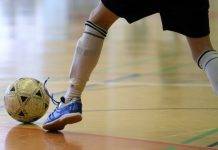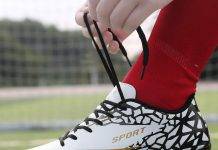Are your soccer cleats starting to feel worn out? Wondering how often you should replace them for optimal performance on the field? Look no further! In this article, we will provide you with the essential information on when it’s time to say goodbye to your trusty pair of soccer cleats and invest in a new one. From the signs of wear and tear to the lifespan of different types of cleats, we’ve got you covered. So lace up your boots, and let’s find out how often you should replace your soccer cleats!
This image is property of footballbootsguru.com.
Factors affecting the lifespan of soccer cleats
Review contents
Quality of materials
The quality of materials used in the construction of soccer cleats plays a significant role in determining their lifespan. High-quality materials, such as durable leather or synthetic fabrics, tend to last longer and withstand the rigors of the game better than lower-quality materials. Cleats made with reinforced stitching and sturdy soles are also more likely to have a longer lifespan.
Frequency of use
The frequency of use is another factor that influences the lifespan of soccer cleats. If you are an avid player who participates in multiple games or training sessions each week, your cleats will naturally wear out faster compared to someone who only plays occasionally. The more you wear your cleats, the more strain and stress they endure, which can lead to accelerated wear and tear.
Playing surface
The type of playing surface you usually play on can affect the lifespan of your soccer cleats. Different surfaces, such as natural grass, artificial turf, or indoor courts, can have varying levels of impact on the cleats. For example, playing on a rough, muddy field can cause more damage to the cleats compared to playing on a well-maintained grass pitch. It is important to choose cleats suitable for the specific playing surface to minimize wear and maximize their lifespan.
Environmental conditions
Environmental conditions, such as extreme heat, cold, or moisture, can also impact the lifespan of soccer cleats. Exposure to excessive heat or prolonged periods of moisture can weaken the materials, causing them to deteriorate more quickly. Similarly, playing in extremely cold temperatures can make the materials more brittle and susceptible to damage. Taking precautions to protect your cleats from harsh environmental conditions can help prolong their lifespan.
Signs that indicate it’s time to replace soccer cleats
Worn-out outsoles
One of the most noticeable signs that it’s time to replace your soccer cleats is when the outsoles start to wear out. The outsole is the bottom part of the cleat that comes into direct contact with the playing surface. Over time, the outsole can become worn down, leading to reduced traction and stability. If you notice significant wear or if the outsole has become smooth and slippery, it is a clear indication that your cleats have reached the end of their lifespan.
Lack of traction
Traction is crucial in soccer, as it allows you to make quick movements, change direction, and maintain stability on the field. If you find that your cleats are no longer providing sufficient traction, it may be time to replace them. Worn out studs or a flattened grip pattern on the outsole can significantly impact your performance, increasing the risk of slips, falls, and potential injuries.
Loss of support
Support is another essential factor when it comes to soccer cleats. As cleats age, the support they provide can diminish. The materials may become stretched or weakened, resulting in reduced ankle support and stability. If you feel that your cleats are no longer giving you the necessary support during play, it is a clear indication that it’s time to invest in a new pair.
Visible damage
Visible damage, such as rips, tears, or loose stitching, is an obvious sign that your soccer cleats need replacing. If the upper part of the cleat is significantly damaged, it can compromise the overall structure and integrity of the shoe. Additionally, any damage to the lining or padding inside the cleat can lead to discomfort and prevent the shoe from providing a secure fit.
Uncomfortable fit
Lastly, an uncomfortable fit is a clear indicator that it’s time to replace your soccer cleats. Over time, the cushioning and padding inside the cleats can degrade, resulting in a loss of comfort and support. If you experience discomfort, blisters, or excessive rubbing during play, it is a good indication that your cleats are past their prime and need to be replaced.
General guidelines for replacing soccer cleats
When it comes to replacing soccer cleats, there are two main approaches: time-based replacement and usage-based replacement. Each method has its benefits and considerations, and deciding which approach to follow may depend on personal preference, budget, and availability.
Time-based replacement
Every season
One common guideline for replacing soccer cleats is to do so at the start of every new season. This ensures that you begin the season with a fresh pair of cleats and can take advantage of any advancements in technology or design that may have occurred during the off-season. Additionally, replacing your cleats every season allows you to assess and address any changes in your foot size or playing style that may have occurred over time.
Every six months
Another time-based replacement option is to replace your soccer cleats every six months. This approach is suitable for players who use their cleats extensively or participate in year-round competitions. By replacing your cleats every six months, you can maintain optimal performance and minimize the risk of wearing them past their useful lifespan.
Every year
For players who use their cleats sparingly or are on a limited budget, replacing them annually may be more practical. While this approach may not provide the latest advancements in technology or design, it allows for an affordable option that still ensures a reasonable lifespan for your cleats. Monitoring the condition of your cleats throughout the year and assessing whether they still provide adequate support and performance can help determine if a replacement is necessary.
Usage-based replacement
In addition to time-based replacement, usage-based replacement focuses on the number of games played, hours of play, or miles covered on the field as indicators for when to replace soccer cleats.
Number of games played
Monitoring the number of games played can be a helpful guide in determining when to replace your soccer cleats. Depending on the level and frequency of games, cleats can experience varying levels of wear and tear. It is important to keep track of the number of games played and assess the condition of your cleats regularly to identify if they are still suitable for optimal performance.
Number of hours of play
Similarly, tracking the number of hours you spend playing in your soccer cleats can give you an idea of when to replace them. The more hours you spend on the field, the higher the wear and tear on your cleats. Consider your playing schedule and the intensity of your training sessions when determining the appropriate time for replacement.
Number of miles covered on the field
For players who participate in longer matches or extensive training sessions, considering the number of miles covered on the field can help determine when to replace soccer cleats. Players who cover greater distances during games or training sessions put more strain on their cleats, causing faster deterioration. By keeping track of the distances covered, you can gauge the level of wear on your cleats and make informed decisions about when to replace them.
Tips to extend the lifespan of soccer cleats
While replacing soccer cleats is inevitable, there are several tips and practices you can follow to extend their lifespan and get the most out of your investment.
Proper cleaning and maintenance
One of the most crucial steps in caring for your soccer cleats is practicing proper cleaning and maintenance. After each use, it is important to remove any excess dirt or debris from the cleats. Using a soft brush or cloth to remove mud and grime from the outsole and upper can help prevent material deterioration and maintain the traction of the cleats. Additionally, allowing the cleats to air dry naturally and storing them in a dry, well-ventilated area can help prevent the growth of bacteria or mold.
Using shoe inserts for cushioning
Using shoe inserts or insoles can help prolong the lifespan of your soccer cleats by providing additional cushioning and support. Insoles can help reduce the impact on your feet and absorb shock during play, minimizing the stress on the cleats. This can help prevent accelerated wear and tear, especially if you are playing on hard surfaces or engaging in high-impact activities.
Rotating multiple pairs of cleats
Investing in multiple pairs of soccer cleats and rotating them can significantly extend their lifespan. By alternating between different pairs, you allow each pair to rest and recover between uses, reducing the overall wear and tear on any single pair. This can be particularly beneficial for players who participate in frequent training sessions or multiple games each week. Furthermore, rotating between cleats of different styles or designs can give your feet a break and prevent specific pressure points from continually bearing the brunt of the activity.
Avoiding excessive strain on the shoes
Avoiding excessive strain on your soccer cleats can go a long way in prolonging their lifespan. Be mindful of any unnecessary activities that could put undue stress on the cleats, such as using them for activities other than soccer or wearing them on hard surfaces for extended periods. Additionally, avoid tying or lacing the cleats too tightly, as this can strain the materials and lead to premature damage.
This image is property of img.adsy.me.
Factors to consider when buying new soccer cleats
When it comes to buying new soccer cleats, several factors should be considered to ensure you make the right choice and find cleats that suit your playing style and preferences.
Personal preference
Your personal preferences and playing style should play a significant role in determining the type of soccer cleats you purchase. Factors such as the fit, style, and overall comfort of the cleats are crucial in ensuring optimal performance on the field. Trying out different styles, brands, and designs can help you find the soccer cleats that best align with your preferences and playing needs.
Playing position
The position you play on the field can also influence the type of soccer cleats you should consider buying. Different positions require different levels of agility, speed, and support. For example, forwards may benefit from cleats with a focus on speed and agility, while defenders may prioritize stability and durability. Understanding the specific demands of your playing position can help you narrow down the options and find cleats that enhance your performance.
Terrain
Considering the type of playing surface you primarily play on is crucial when buying new soccer cleats. The different surfaces, such as natural grass, artificial turf, or indoor courts, may require specific types of cleats for optimal performance. Cleats designed for natural grass may have longer studs to provide better grip, while cleats for artificial turf may have shorter studs or rubberized soles. Matching the cleats to the specific playing surface will ensure that you can perform at your best and reduce the risk of discomfort or injury.
Budget
Setting a budget is an important factor to consider when buying new soccer cleats. Soccer cleats can vary significantly in price, with higher-end cleats often offering advanced features and technologies. It is essential to find a balance between your budget and the quality and durability of the cleats you desire. Prioritizing your needs and preferences within your budget will help you find the right cleats without overspending.
Finding the right replacement soccer cleats
Finding the right replacement soccer cleats involves a combination of research, experimentation, and seeking recommendations.
Researching different brands and models
Conducting thorough research on different brands and models of soccer cleats is essential when looking for a replacement. Online reviews, customer feedback, and expert opinions can provide valuable insights into the performance, durability, and overall quality of different cleats. Take the time to compare features, prices, and customer experiences to make an informed decision.
Trying on different sizes and styles
Trying on different sizes and styles of soccer cleats is crucial to finding the right fit and comfort. Every brand and model can have slight variations in sizing, so it is important to physically try them on before making a purchase. Walk or jog around in the cleats to assess their comfort level and ensure there are no areas of discomfort or pressure points. Finding the right fit will not only enhance your performance but also help prevent injuries.
Seeking recommendations from professionals
If you are unsure about which soccer cleats to choose, seeking recommendations from professionals can be extremely helpful. Coaches, trainers, or experienced players can provide valuable insights based on their knowledge and experience. They can offer guidance on specific brands, models, or features that may be beneficial for your playing style or position.
This image is property of premiumsoccer.com.
How to properly dispose of old soccer cleats
Once your soccer cleats have reached the end of their lifespan and are no longer suitable for use, it is important to dispose of them properly to minimize environmental impact and provide opportunities for others in need.
Donating to charitable organizations
Donating your old soccer cleats to charitable organizations can be a great way to give them a second life and help those in need. Many organizations and programs collect used sports equipment to distribute to individuals or communities who may not have the means to purchase new gear. Research local charities, schools, or youth organizations that accept sports equipment donations, and ensure your cleats are in decent condition before donating.
Trading or selling them
If your old soccer cleats are still in good condition and can be used by others, consider trading or selling them. Online platforms, consignment stores, or local sports shops may offer opportunities to sell or trade your old cleats with other players who are looking for affordable options. This can also help you recoup some of the investment you made in your cleats.
Recycling options
If your soccer cleats are too worn out or damaged to be donated or sold, you can explore recycling options. Some companies specialize in recycling sports equipment, including soccer cleats, and repurpose the materials for other purposes. Research local recycling programs or contact recycling centers to inquire about their policies on sports equipment recycling.
Conclusion
Taking care of your soccer cleats and knowing when to replace them is essential for maintaining optimal performance and preventing injuries. Factors such as the quality of materials, frequency of use, playing surface, and environmental conditions can significantly impact the lifespan of your cleats. Signs such as worn-out outsoles, lack of traction, loss of support, visible damage, and an uncomfortable fit indicate that it’s time to invest in a new pair. Following general guidelines for replacement, along with time-based and usage-based approaches, can ensure that you have the appropriate footwear for optimal performance. Implementing tips to extend the lifespan of your soccer cleats, considering factors when buying new ones, and finding the right replacements through research and recommendations can help you make informed decisions. Lastly, properly disposing of old soccer cleats through donation, trading, selling, or recycling allows you to give them a second life or minimize environmental impact. By following these guidelines, you can enjoy the game with comfortable, supportive, and durable soccer cleats.
This image is property of i0.wp.com.









































